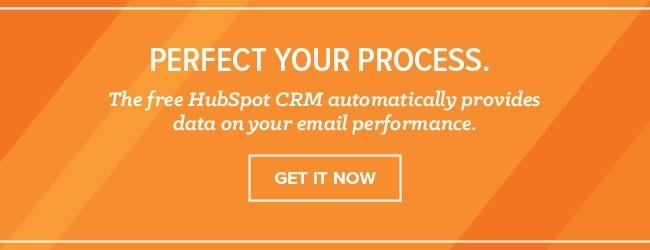Five months ago, I began spending most of my time writing about sales. My motivation: Buyers have drastically changed the way they buy. But salespeople seem to be a few steps behind.
Rather than going the route that HubSpot co-founders Brian Halligan and Dharmesh Shah took when they pioneered inbound marketing, I decided not to sit down and start writing a book -- at least, not in the way that most books have been written in the past. Instead, I started writing a book one blog post at a time.
A few months later, I've written enough posts to fill a book. While I'm still not quite ready to start killing trees, I am more convinced than ever that sales and salespeople need to change. In fact, much of my writing has been in reaction to the played-out approaches I see droves of salespeople still using.
We have a lot of work to do yet. Not just to write “the” book, but to figure out new and better sales approaches and then spread them far and wide. And I need your help.
Are you interested in figuring this out with me? If so, join me for a live chat session on HubSpot's Slack channel today at 11 AM EST. To join the discussion, register for our Slack channel here, and you’ll receive an invite shortly thereafter.
In order to get our conversation rolling, I've written a rough draft below of how the book might be structured, complete with links to many of my already-published articles. Join the live chat session with me and other salespeople if you'd like to discuss any of these topics.
Chapter 1: Your Attitude Towards Sales Must Change. Now.
I have a simple sales philosophy I follow that I largely inherited from my sales coach: Sales is about helping the people who you can help, who both want and need your help.
To do this, salespeople must be experts at what they do, identify and find the right prospects, publicly make themselves visibly available to help, diagnose like a doctor would, and recommend the right solutions -- whether it leads to an immediate sale or not. It's a relatively simple approach to explain, but difficult and elusive for most salespeople in practice.
Why? Salespeople and sales leaders are always on the lookout for shortcuts; those magical, low-effort, cookie-cutter approaches to meeting their target or padding their commission check. However, not only does this one-size-fits-all “magic bullet” approach not exist (or work for long), most of these types of quick fix strategies more often than not destroy trust between salespeople and the prospects they're trying to help.
As many other sales experts agree, salespeople can avoid this short-term thinking if they (and their organizations) invest in marketing their expertise and double down on moving from outbound to inbound tactics instead of cold calling.
Chapter 2: Build an Amazing Team and Support Them -- Even Better Than You Are Today.
The first step in creating amazing results for your company and your clients is to invest in your team. This is nothing new.
But this doesn’t necessarily translate into perks and motivational boosts. Buyers are treating salespeople with less and less respect these days as they become more and more self-sufficient in terms of finding and prescribing their own solutions to challenges. For that reason, interviewing for sales hires must simulate the worst of the worst clients calls, so that you can ensure your salespeople will be resilient.
Once they are hired, you must prioritize coaching your salespeople and leading them as much as managing them. You also must address bad behavior quickly and decisively.
And last but not least -- you must be agile, changing systems as your company grows or as outside factors affect your business.
Chapter 3: Document the Sales Approaches that Work.
If there's one thing I learned as I went from salesperson to sales leader, it's the importance of a thoroughly documented, consistently updated, simple-to-follow sales process.
While I'm personally a big fan of figuring things out as I go, using established best practices makes life a lot easier when teaching people. That's why we spent the last several months constructing a new sales methodology and launching a free sales training course.
While the sales methodology is new and unique, it also builds upon tried-and-true, eternally relevant sales best practices that can be found in many valuable sales books and courses.
That said, most existing sales methodologies and sales books fail to teach salespeople how to make the critical initial connection to uber-busy buyers, and this is key in modern selling.
Chapter 4: When in Doubt, Fill the Top of Your Funnel.
If you can't control the number of conversations your salespeople have with new prospects every day, you won't be able to control your organization’s future.
Unfortunately, the dated approaches most sales organizations still use just aren’t working anymore -- not to mention that they are actively raising the ire of most prospects. My most popular article by far is "Salespeople, Please Stop Sending Prospecting Emails Like This One." What’s behind its success? My theory is that buyers share it because they want salespeople to stop sending terrible emails, salespeople read it because they know what they're doing isn't working anymore, and sales managers share it because they are desperate for proof that hitting quota shouldn’t require sacrificing their soul.
Some people think that social selling is the future -- and I agree that it's important. But, it isn't a silver bullet. Plus, a subset of salespeople are in the process of ruining LinkedIn with their spammy ways.
Some salespeople are responding to the increased rate of buyers ignoring them by just increasing their outreach frequency. But, that's backfiring too.
Salespeople need to get better at prospecting, not just increase the number of messages they send. The right mechanics for prospecting are table stakes, but to really move the needle, they have to transform their approach and messaging.
Instead of initiating short-sighted conversations that can be summarized as “I have something to sell -- would you like to buy it?”, salespeople must initiate a dialogue based on what prospects want to talk about. Many buyers share their interests and initiatives online. Salespeople need to pay attention, read between the lines, and start a conversation that's related to these interests using personalized, relevant, and relationship-building messages.
Chapter 5: Put Your Prospects' Needs First.
The bad behavior isn’t limited to the prospecting phase. If only. The initial connect call is often far less than perfect.
When the dialogue is just beginning, before the salesperson has had a chance to establish themselves as an expert who can help, they must defer to a prospect's communication preferences. They also must avoid using language that suggests they care more about selling than helping.
T hese two steps will help you break down initial resistance. Then once the conversation is flowing, salespeople need to ask what prospects want to talk about. Regardless of the salesperson’s agenda, discussions must stay or get focused on a prospect's needs. Reps must ask thoughtful questions that help them fully understand a buyer's situation, and master the art of active listening.
Many salespeople would love to do these things, but they can’t due to weaknesses and self-limiting beliefs. Sales leaders must diagnose and coach problem areas that discourage reps from asking tough questions.
Chapter 6: Make Buying a Foregone Conclusion.
While some books and sales courses spend lots of time on closing skills and best practices, a book about inbound selling won't need to. While asking for the business is certainly a skill that salespeople still and will need, the fat opt-in funnel that results from effective inbound marketing, prospecting, and qualifying makes buying a foregone conclusion for the right prospects.
And while we’re talking about the “right” prospects -- the benefits of a strong qualification process and skills are numerous (12 to be exact). Closing problems often stem from poor qualification in my experience. If you’re ready to fix a crappy qualification process, focus your attention on these four areas.
Today, buyers can spot old-school closing and upselling techniques from a mile away. The key closing approach salespeople need to master to effectively sell to the modern buyer is the ability to help them make informed decisions. In addition, reps need to set proper expectations about what it takes for a buyer to be completely happy and successful with their purchase up front, so there are no unpleasant surprises later.
Chapter 7: Improve Efficiency via Technology.
As I'm employed by a software company, you might be surprised I haven't mentioned the importance of technology yet. Not one to disappoint; you certainly can choose to employ technology to improve sales efficiency. While inbound selling methods alone will bring increased efficiency and effectiveness once fully embraced, technology is a quick and complementary way to boost productivity.
I’m of course biased, but I believe our sales technology enables this transformation for organizations better than any other. Our customers are helping us write the chapters on using technology to crush quota, and blazing the inbound sales trail. Together, we can abolish crappy selling -- for good.
Help Us Figure Out the Future of Sales
While the outline above is a good start for our book on modern selling, we still have a whole lot more to figure out. The story is incomplete because we haven't solved the problems fully yet. It’s only half-written.
Let’s focus the second half of the book on how we changed the sales profession to not just adapt to the modern buyer, but to produce significantly better results than we've ever dreamed -- across industries, and for companies both big and small. That’s my quest, and I hope you'll join me.
Meet me on Slack today, and let’s have a conversation. All questions, stories, and pushback are welcome.
Join our Slack channel here and submit questions ahead of time if you’d like.
If you can't make the live session and want to collaborate, connect on Twitter or join my collaborator's newsletter where I invite sales professionals to contribute to future articles. Who knows? You might end up in the book.












